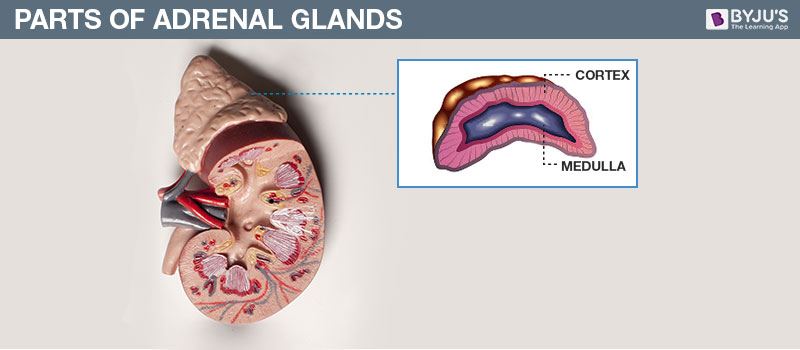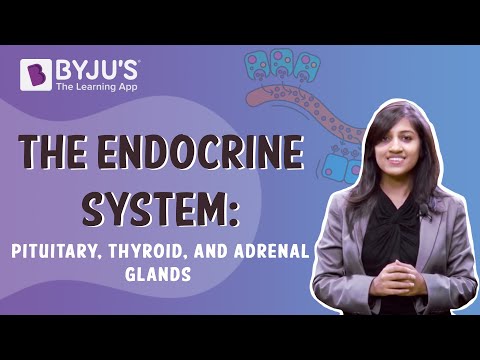The adrenal glands are endocrine glands that perform quite a lot of functions in the body. Read on to explore its significance, the location and function of the adrenal glands.
| Table of Contents |

Adrenal Gland Location
The Adrenal Glands are found on top of each kidney. Even the name “Adrenal” directly refers to their location: (Latin: ad– “near” and renes – “kidneys.”) These glands are also known as suprarenal glands. (Latin: supra – “above” and renes – “kidneys.”)
On the anterior side of the right adrenal gland sits the Inferior vena cava and the right lobe of the liver. The posterior side is flanked by the right crus of the diaphragm. The stomach, pancreas and spleen sit on the anterior side of the left adrenal gland. The posterior side is flanked by the left crus of the diaphragm.
Adrenal Gland Anatomy
- As stated in the introduction, the human body has two adrenal glands, the right gland is pyramidal in shape and the left gland is semilunar in shape.
- The left adrenal gland is also comparatively larger than the right.
- The glands are usually about 5×3 cm in size and their combined weight ranges from 7 to 10 grams. Healthy glands are yellowish in colour.

There are three distinct layers of the adrenal glands.
Adrenal Capsule
The capsule is a protective layer of fat that surrounds each adrenal glands. They are not strictly a part of the adrenal glands, but the primary function of this capsule layer is to enclose and protect each of the adrenal glands.
Adrenal Cortex
The adrenal cortex is the outermost layer of the adrenal gland which is devoted to the production of aldosterone, cortisol, and androgens hormones. There are three layers of cortex called zones which can be examined and easily differentiated under a microscope:
- Zona glomerulosa – It secretes mineralocorticoids like aldosterone
- Zona fasciculata – It is responsible for producing corticosteroids like cortisol. Also secrets small quantities of androgens (such as testosterone and androstenedione)
- Zona reticularis – It produces DHES or dehydroepiandrosterone (also called androstenolone)
Adrenal Medulla
The last and innermost part of the adrenal gland is the medulla. It contains the Chromaffin cells, which produce the body’s main source of catecholamines (such as adrenaline and noradrenaline) and endorphins. These are stored and released in response to stress.
Adrenal Gland Function
- One of the most well-known responses – the Fight or Flight Response is triggered by the release of stress hormones from the adrenal glands.
- The adrenal glands produce a variety of hormones. These hormones are very crucial for the normal functioning of the body. For instance, the glands secrete cortisol, which has anti-inflammatory properties and aids the immune system.
- The adrenal gland also helps to regulate metabolism and blood pressure through various other hormones.
Adrenal Gland Hormones
- Epinephrine: Also called adrenaline, this hormone rapidly responds to stress by increasing the heart rate and raising blood glucose levels in the blood.
- Norepinephrine: Also called noradrenaline, this hormone works with epinephrine in reacting to stress. Its primary function is to mobilize the body and brain for action.
- Hydrocortisone: It is commonly known as cortisol or a steroid hormone. It is involved in regulating body functions like the conversion of fats, and carbohydrates to energy and also plays a vital role in other metabolic processes.
- Corticosterone: This hormone works with hydrocortisone to control the immune response and prevents inflammatory reactions.
Adrenal Gland Disorders
Adrenal Gland disorders appear when not enough hormones or inadequate hormones are produced by the adrenal glands. Even abnormal growths or tumours can cause certain illness.
- Cushing’s Syndrome is a condition where the cortisol levels in the body are very high. The cause can be a tumour in the adrenal gland or the pituitary gland.
- Adrenocortical carcinoma is a cancerous tumour that usually develops in the outer layer of the adrenal gland. This type of tumour is typically found years after they have spread to other organs in the body.
- Congenital Adrenal Hyperplasia (CAH) is a genetic disorder characterized by very low levels of cortisol production. The people inflicted with this condition may also have other hormonal imbalances where their bodies may make very little aldosterone, but too much androgen.
- Addison’s Disease is caused when adrenal glands produce insufficient cortisol or aldosterone. It results in weakness, fatigue, low blood pressure, nausea, etc. In 70% of cases, Addisone disease is caused due to autoimmune disorder, where the body mistakenly attacks the adrenal glands. As a result, the adrenal gland does not produce the hormone aldosterone in sufficient quantities.
Recommended Video:

Frequently Asked Questions
1. What are Adrenal Glands?
Adrenal glands are endocrine glands that are responsible for producing important hormones required for metabolic functions and stress response.
2. Where are the Adrenal glands located?
The adrenal glands are present above each kidney.
3. What is the function of the adrenal glands?
The adrenal glands help in metabolism, regulates blood pressure, and is responsible for the fight or flight response.
4. What are the signs of adrenal gland problems?
Problems with the adrenal gland typically arise with the formation of a tumour. Sometimes, the tumours may influence the production of certain important hormones by either accelerating or inhibiting it.
5. What is the importance of the adrenal glands?
The adrenal gland secretes certain hormones into the bloodstream, which then prepares the body for mobilization. It also produces sex hormones as well as cortisol, which is paramount for survival.
Further Reading: Endocrine Glands And Hormones


very nice notes